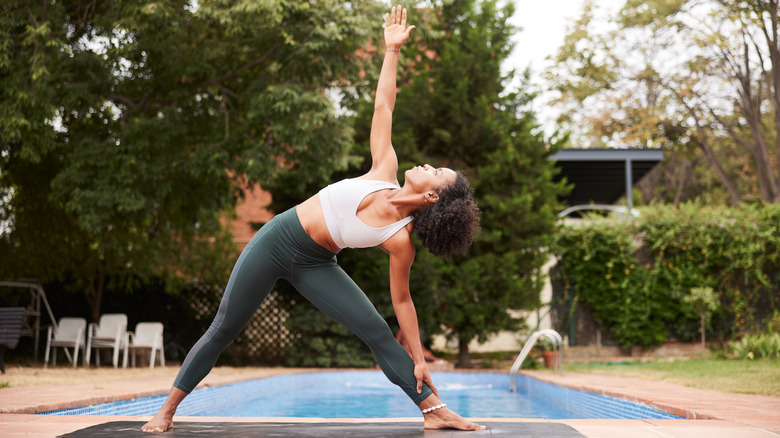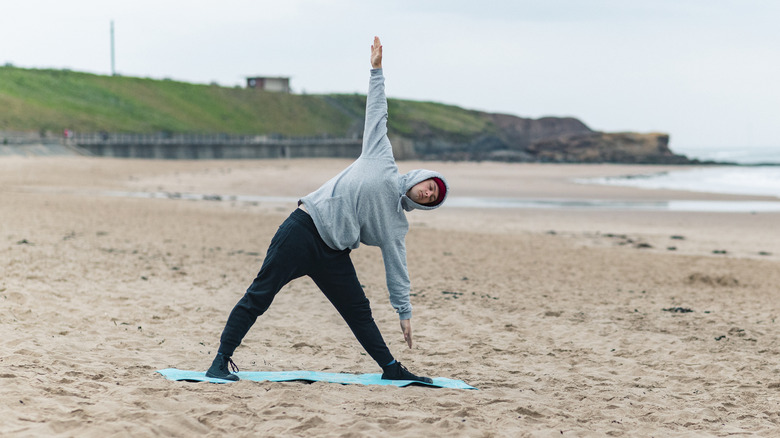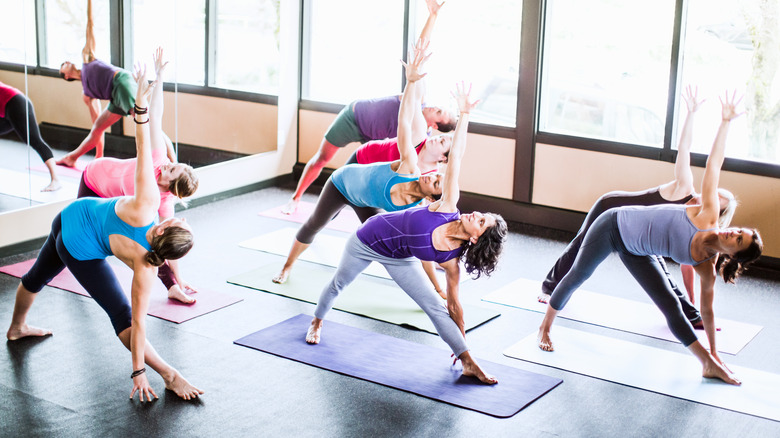The Benefits Of Doing Triangle Pose In Yoga
Triangle pose, or trikonasana in Sanskrit, is a fundamental yoga posture found in all levels of yoga practices. The pose gets its name because your lower body creates a stable triangle. Though this pose is named for the distinctive shape that the legs make, your upper body will also feel some twisting and opening. This standing pose can be practiced on its own in a hatha yoga class, or it could flow into a warrior two pose and reverse warrior.
If you've ever tried practicing triangle pose, you'll quickly notice its benefits. As you form a stable base with your legs, you're strengthening them while working on your balance. You'll also feel the smaller muscles around your feet and ankles helping to keep you stable. Triangle pose gives you a delicious stretch in your hips, hamstrings, calves, and spine while opening your chest and shoulders. Because your torso is engaged in a gentle twist, triangle pose also stimulates digestion (via CNY Healing Arts).
How to do triangle pose
To try triangle pose, stand with your legs a few feet apart, with enough distance to feel a stretch in your groin and inner thigh. If you're practicing triangle pose on a yoga mat, spin your front foot 90 degrees so your toes face the short edge of your yoga mat. Your back foot can point towards the long edge of the mat or angle a few degrees inward. Anchor both feet into the ground, and keep a micro bend in your knees so you're not locking your knee joints.
Extend your arms straight out so your wrists and legs are all on the same plane. Let your right arm lead your torso towards the right until you can't reach further. Now twist your torso slightly as you lower your right arm towards your right calf or ankle. Keep your left arm reaching upward to work against the pull of gravity. Try to keep both arms perpendicular to the floor. Your chest and shoulders should be open and facing the long side of your mat. You can fix your gaze towards the floor to help with balance, or you can look up towards your left arm if your neck allows. Hold the posture for up to 10 breaths, then use the strength of your arm and core to pull you back up to standing. Repeat with the other side by switching the angle of your feet (via Art of Living).
Modifications of triangle pose
People with high blood pressure might want to avoid raising the top arm in triangle pose. Because triangle pose involves the head being below the heart, people with migraines might also want to skip this pose (via Art of Living).
Using a block in triangle pose might make it more accessible for beginners, especially if you can't reach your ankles or if holding onto your shin feels unstable. You'll place a yoga block next to your front foot to help give you a little more stability. Having a stool or a chair nearby can also make triangle pose a little easier.
The support of a wall can help you modify triangle pose. Start the pose with your back to the wall and turn your feet in the same way you would in the freestanding pose. The wall will give you a little more confidence as you work on your balance in the pose.



